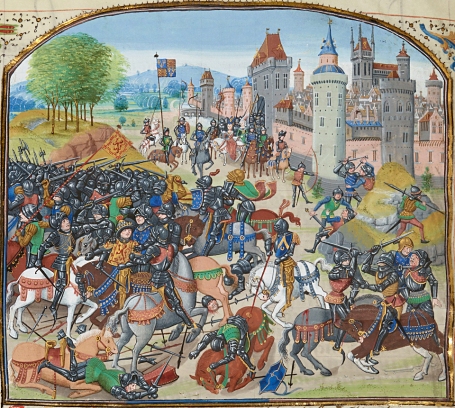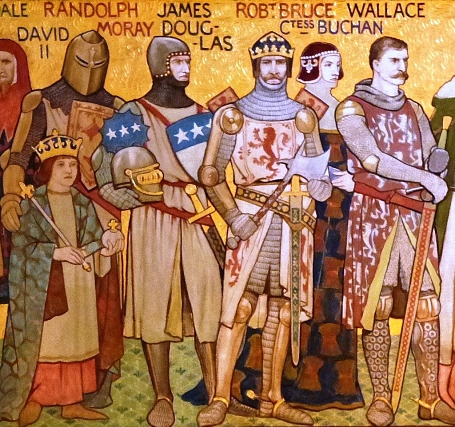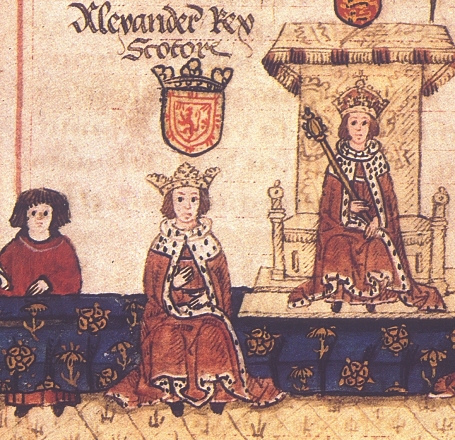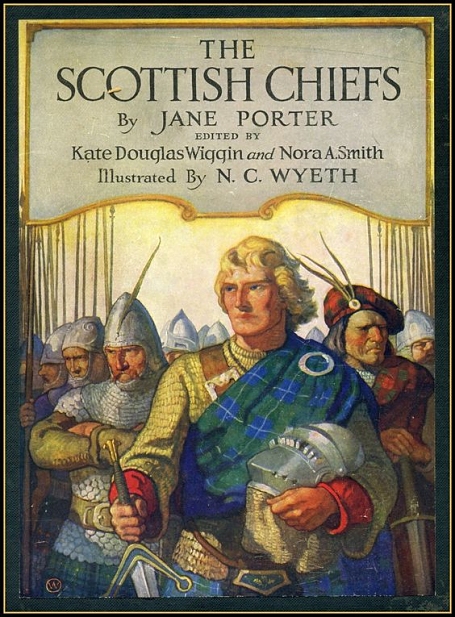The Life and Heroick Actions of the Renoun'd Sir William Wallace,
General and Governour of Scotland
by William Hamilton of Gilbertfield
Synopsis (Continued)
Winter: the wind blows out of the north, snow fills the glens, the days are so short that the sun barely rises before it sets again. The nights are long and gloomy for the outlaws who can't trust anyone enough to put a roof over their heads.
Wallace has posted sentries, suspecting that the English in Perth will be looking for him, since the arrangement they made with his leman fell through. The young lady saves herself while the English gather an army. Six hundred well-armed men, aided by a bloodhound, head out to find Wallace and his men in the forest. As they leave Perth they find the two watchmen that Wallace killed.
Sir Gerard Heron surrounds the forest with half the English force, while Butler takes three hundred men into the midst of the woods. Wallace and his men, outnumbered seven-to-one, fight their way through Butler and his men; fifteen Scots are killed, forty English die. Wallace's men are making their way toward the Tay, but Wallace encourages them to fight rather than risk drowning while attempting to cross the water. "With new courage" they turn, face Butler's men and continue the fight. Sixty more Englishmen are killed, and nine Scots, leaving Wallace with only sixteen men, which include Stephen of Ireland, Kierly and Fawdon.
Wallace and his men manage to evade the English, who send the bloodhound to track them down again. The English pursue on horseback while the Scots run and climb rising ground for two miles before they get to a protected area. It's getting dark and they have hope of getting away, but Fawdon is tiring. Wallace doesn't want to leave him behind and encourages him to carry on, but Fawdon can go no further. Enraged, Wallace draws his sword and with one stroke, beheads Fawdon. Here, a judgement is made that Wallace was in the right to kill Fawdon: they'd not gone far and Fawdon was a strong man in his prime, thus he must have had an ulterior motive for slowing them down. Wallace's men support the killing of Fawdon, cheering as they climb the mountain, "swift as deer."
Ireland and Kierly have become separated from the rest of Wallace's men as night sets in. When the English come across Fawdon's body, the bloodhound gives up the chase. Stephen and Kierly blend in with the crowd of Englishmen that surround the corpse, eavesdropping. The English come to the conclusion that the Scots have been fighting amongst themselves. As Sir Gerard leans over to take a close look at Fawdon's body, Kierly stabs a dagger up under his armor and kills him. Gerard slumps to the ground; the Englishmen cry out that Wallace is responsible and great confusion ensues, which allows Stephen and Kierly to slip off into the dark.
Maddened by the attack on Gerard, Butler sends part of his force to bury the dead, some to the woods and some to the fields. He gathers a strong force of men and, with them, guards the passes through the night.
Wallace, suddenly noticing that Stephen and Kierly aren't with him, searches the woods in vain for them, and eventually sets up a camp near Gaskhall. They build a fire and take two sheep from a neighboring farm, on which they dine. They hear a loud blast from a horn and Wallace sends two men to see who's blown it. As they wait for the two men to return, they hear the horn again, closer. Wallace sends two more men, then the remaining nine men, one by one. "Thus he was left alone."
The sound is getting louder and closer. Wallace, unnerved, takes up his sword and goes out the gate where he sees Fawdon, holding his head in his right hand. Wallace makes the sign of the cross; the ghost throws its head at Wallace; Wallace catches it and throws it back, runs up the stairs then jumps out of a window and runs up the riverbank. He turns back once and sees the tower on fire, with Fawdon standing on top. Frightened, bewildered and grieving for the loss of his men, Wallace roams aimlessly throughout the night.
In the morning Butler rides out on the plains by himself where he sees an upset man standing alone. He rightly guesses that it's a Scot and demands to know his business, riding at him. Wallace sustains the blow from the horse, knocks Butler off the horse, mounts and rides away. An English soldier throws a spear at Wallace as he rides away, but misses. The English, rallying quickly, surround Wallace, but he cuts his way through them with his sword. They pursue him throughout the day and Wallace kills twenty-three as, "Fearless, he inches back."
Night falls and Wallace takes a moment to catch his breath before moving on. He becomes lost in the boggy plains, his horse stumbles and falls, Wallace continues on foot, finally coming to the Firth of Forth. He plunges in and, using his sword as a rudder, chilled and exhausted makes land on the other side. He takes refuge in the house of a widow, whose maid he sends to Gaskall to look for his men while the widow tends to him. The widow's sons guard him as he sleeps.
The ballad, The Life and Heroick Actions of the Renoun'd Sir William Wallace, General and Governour of Scotland, by William Hamilton of Gilbertfield, 1722, is in the public domain.

The Kingdom of England and the Kingdom of Scotland fought dozens of battles with each other. They fought typically over land, particularly Berwick-Upon-Tweed, and the Anglo-Scottish border frequently changed as a result. Read more at Wikipedia.

The First War of Scottish Independence was the initial chapter of engagements in a series of warring periods between English and Scottish forces lasting from the invasion by England in 1296 ... Read more at Wikipedia.

Edward I (1239-1307), also known as Edward Longshanks and the Hammer of the Scots, was King of England from 1272 to 1307. Read more at Wikipedia.

Digitized version of The Scottish Chiefs, by Jane Porter, a novelization published in 1921 by Charles Scribner's Sons, about William Wallace and the First Scottish War of Independence. Read online at archive.org.